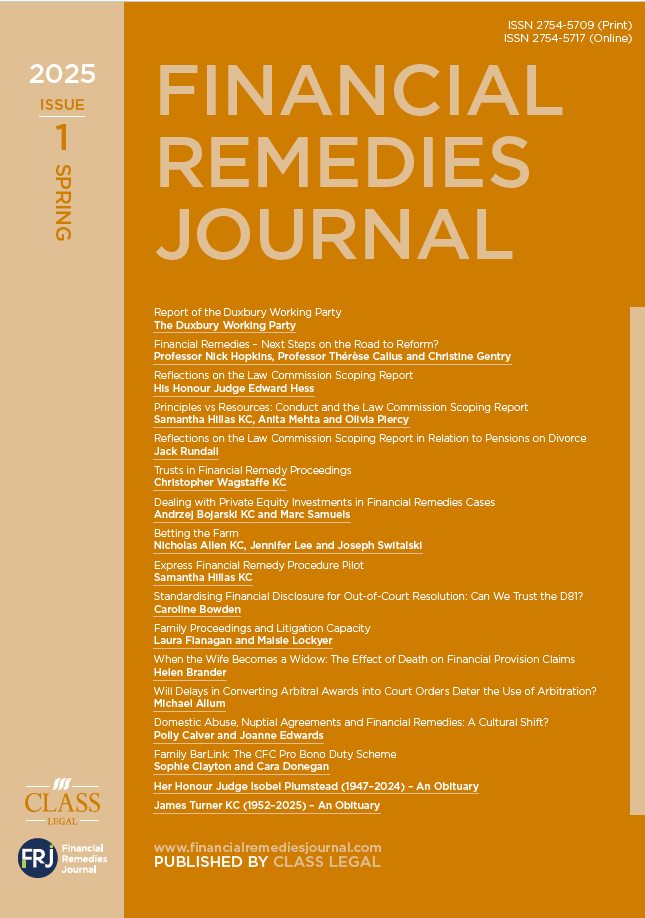Separation Agreements: Mostyn J’s Final Revolution?
Despite Mostyn J’s comment in one of his final cases, Baker v Baker [2023] EWFC 136, that it posed ‘no real issues of law’,[[1]] his judgment arguably sought to revolutionise the law on separation agreements. Whilst separation agreements have long been treated as one factor – albeit a weighty one – in the section 25 exercise, Mostyn J held that attempts to depart from them should be treated ‘in much the same way’ as applications to vary consent orders – meaning that the capital elements could not be departed from as to quantum absent grounds for a successful set aside application. Whilst this would be a significant departure from the existing law, I suggest that if combined with an assessment of whether the agreement would have been approved as a consent order when made, it may provide a useful lens and produce similar results to recent caselaw. However, whether such an approach would always provide a fair outcome remains questionable.
The background: Edgar, MacLeod and Radmacher
The leading authority on separation agreements is Edgar v Edgar [1980] EWCA Civ 2. The key paragraph from Ormrod LJ’s judgment sets out:
‘To decide what weight should be given in order to reach a just result, to a prior agreement not to claim a lump sum, regard must be had to the conduct of both parties, leading up to the prior agreement, and to their subsequent conduct, in consequence of it … So, the circumstances surrounding the making of the agreement are relevant. Undue pressure by one side, exploitation of a dominant position to secure an unreasonable advantage, inadequate knowledge, possibly bad legal advice, an important change of circumstances, unforeseen or overlooked at the time of making the agreement, are all relevant to the question of justice between the parties. Important too is the general proposition that, formal agreements, properly and fairly arrived at with competent legal advice, should not be displaced unless there are good and substantial grounds for concluding that an injustice will be done by holding the parties to the terms of their agreement. There may well be other considerations which affect the justice of this case; the above list is not intended to be an exclusive catalogue.’ (Emphasis added).
In MacLeod, however, the Board (whose unanimous advice was authored by Lady Hale) criticised the Court of Appeal in Edgar for not considering ss 34–35 MCA 1973, and Mostyn J drew on their approach in Baker.
The provisions originated in the Maintenance Agreements Act 1957 to enable the court to enforce and vary maintenance outside divorce proceedings at a time of limited access to divorce. Section 34(2) MCA 1973 defines a maintenance agreement as:
‘any agreement in writing made … between the parties to a marriage, being:
(a) an agreement containing financial arrangements, whether made during the continuance or after the dissolution or annulment of the marriage; or
(b) a separation agreement which contains no financial arrangements in a case where no other agreement in writing between the same parties contains such arrangements.’
Section 34 renders maintenance agreements binding save that they cannot restrict a party’s right to apply to court for financial provision. Section 35 empowers the court to vary maintenance agreements where there has been a ‘change of circumstances in the light of which any financial arrangements’ were made, or where the agreement did not contain ‘proper financial arrangements’ for a child of the family. Section 35(6) stipulates that the provisions do not affect the court’s power to make financial provision under any other sections of the Act.
The Board held that separation and post-nuptial agreements were ‘maintenance agreements’ which could be enforced or varied under ss 34–35.[[2]] Whilst recognising that the statute does not address the weight to be given to a maintenance agreement in a subsequent application for financial relief, they considered it:
‘would be odd if Parliament had intended the approach to such agreements in an ancillary relief claim to be different from, and less generous than, the approach to a variation application. The same principles should be the starting point in both’.
The Board therefore held that in an application for financial relief where there is a post-nuptial or separation agreement:
‘the court is looking for a change in the circumstances in the light of which the financial arrangements were made, the sort of change which would make those arrangements manifestly unjust, or for a failure to make proper provision for any child of the family.’[[3]]
However the Board went on to say that they ‘would also agree that the circumstances in which the agreement was made may be relevant in an ancillary relief claim’, endorsing Ormrod LJ’s approach in Edgar.[[4]]
When Radmacher came before the Court of Appeal the following year, Wilson LJ took the opportunity to set out his views on the Privy Council’s approach:
‘The suggested introduction into the consideration of post-nuptial contracts in proceedings for ancillary relief following divorce of an analogy with the power to alter a maintenance agreement under s 35 is, if I may speak for myself, entirely unexpected; and it will need careful, albeit genuinely respectful, scrutiny … Sections 34 and 35 have been dead letters for more than thirty years … To chart changes, foreseen or unforeseen, pursuant to s 35 of the Act of 1973 seems to me to be a very different exercise from that of weighing all the circumstances ab initio under s 25 of it; and … it may be helpful for courts at any rate to remember that the weighing exercise under s 25 is mandatory.’[Radmacher v Granatino (Rev 1) [[5]]
When Radmacher came before the Supreme Court, the majority held that ss 34–35 could not apply to post-nuptial agreements as such agreements were contrary to public policy when the MCA 1973 was passed. They did however indicate the s 35 variation test (requiring a change of circumstances or inadequate provision for a child) and the Edgar test were ‘appropriate for a separation agreement’.[[6]] It was argued that because separation agreements are designed to take immediate effect, it ‘makes sense to look for a significant change in circumstances as the criterion justifying a departure from the agreement’. However, the point was obiter and, until Baker, subsequent reported separation agreement cases made no reference s 35, but analysed separation agreements by reference to the principles in Edgar and Radmacher.[See e.g. Zimina v Zimin [[7]]
‘Where a party makes a financial remedy application the object of which is to enforce a separation agreement which contains income terms as well as capital terms the approach of the court when weighing that agreement in the discretionary exercise should be, in my judgment, to treat it in much the same way as an application to vary a consent order. It would be odd if there were a markedly different approach to the treatment of an agreement incorporated in a consent order and to an agreement incorporated in a separation deed.’[Baker v Baker [[8]]
There is, plainly, an important difference between separation agreements and consent orders: the latter have been found to be fair by a judge. As is often said, the Family Court does not merely act as a rubber stamp when considering consent orders.[A recent example being the Court of Appeal in Haley v Haley [[17]]
- In MB v EB [2019] EWHC 3676 (Fam) the husband had minimal assets and income whereas the wife was very wealthy. A 2011 separation agreement had made limited provision for the husband which did not meet his needs. Cohen J did not hold the parties to the agreement, in part because it did not ‘ever provide satisfactorily for the meeting of the husband’s income and capital needs’. He added: ‘This is not providing an ‘after the event’ insurance. It is meeting a need that was always there’. This is essentially a finding that the agreement would not have been approved as a consent order in 2011 as it did not meet the husband’s needs.
- In Horohoe v Horohoe [2020] EWFC 102 one provision of the parties’ separation agreement was based on a mutual mistake as to the value of the husband’s business. Holman J held that in ‘all respects bar one, the agreement was at the time fair to both parties’. He therefore held the parties to the agreement subject to isolating and remedying that issue – an approach that could well have been taken in an application to set aside a consent order for mistake.
- In NO v PQ [2023] EWFC 36, Recorder Rhys Taylor held the husband to an informal separation agreement notwithstanding that it left him in a predicament of real need. On the parties’ separation in 2018 they had agreed that the husband’s new business venture would be funded from what would be his share of the assets. He ended up losing £776,000, leaving only £625,000 in the family pot. Recorder Taylor considered that as the agreement was fair at the time it was made, it had ‘magnetic force’.
But will it always be appropriate to hold parties to a separation agreement which was fair when it was made, absent a legitimate set aside or variation argument? Should nothing turn on the fact that no application to turn it into a court order was ever made? Could fairness require the court to go behind a separation agreement which was fair when it was made, even if there are no vitiating factors and no grounds on which a variation or set aside application could be made?
The High Court may soon have to consider these questions when determining the case reported at an interim stage as HAT v LAT [2023] EWFC 162. The unusual facts involve a husband who made significant capital and income provision for his former wife from 2002 until 2022, despite a 1994 separation agreement providing for a clean break. In awarding interim maintenance, Peel J said that he did not:
‘at this stage regard W’s claims as doubtful or speculative … although they are likely to be significantly curtailed by reason of the deed of separation and the passage of time … W can point to the financial support for at least two decades which, arguably, generated dependency and, on her case, was explicitly on the basis that such support would continue for her lifetime.’
Notwithstanding that ‘hard cases make bad law’, it is to be hoped that the final judgment in HAT v LAT will clarify the approach to be taken to separation agreements, and the relevance – if any – of the ‘variation analogue’ or ss 34–35 MCA 1973.
[[1]]: At paragraph 12.
[[2]]: Pre-nuptial agreements were not, having not been made between ‘the parties to a marriage’ or ‘during the continuance or after the dissolution of annulment of the marriage’.
[[3]]: At paragraph 41. Note however that in her dissenting judgment in the Supreme Court’s decision in Radmacher Lady Hale reflected that there had been ‘no warrant for the inclusion of the word “manifestly” before “unjust”’ (paragraph 168).
[[4]]: At paragraph 42.
[[5]]: 2009] EWCA Civ 649 at paragraph 134.
[[6]]: At paragraphs 64–65.
[[7]]: 2017] EWCA Civ 1429. Whilst this was a Part III case in which the wife sought additional provision after a Russian consent order, King LJ gave guidance on separation agreements, holding that the trial judge should have considered the Russian agreement not only by reference to Radmacher but also to Edgar, such that the original agreement should not be displaced unless there are good and substantial grounds for concluding that an injustice would be done by holding them to it.
[[8]]: 2023] EWFC 136, [98].
[[9]]: Paragraph 99.
[[10]]: Paragraph 108.
[[11]]: Paragraph 103(iv).
[[12]]: Paragraph 107.
[[13]]: Paragraph 115.
[[14]]: Paragraph 116.
[[15]]: Paragraph 142.
[[16]]: Paragraph 143.
[[17]]: 2020] EWCA Civ 1369, at [39].




